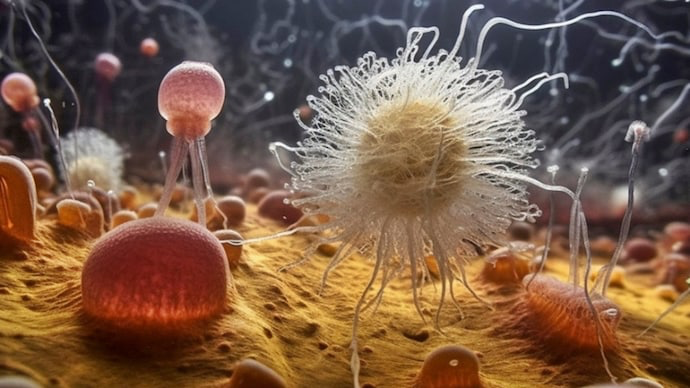Description

Disclaimer: Copyright infringement not intended.
Context: A recent scientific discovery of a lost world that sheds light on the evolution of life on Earth. Scientists have found ancient organisms called Protosterol Biota that existed over 1.6 billion years ago and played a crucial role in the evolution of complex life.
Details
- Scientists have made a significant discovery of a lost world that provides insights into the evolution of life on Earth.
- The newly identified organisms, called Protosterol Biota, inhabited the underwater world over 1.6 billion years ago and played a crucial role in the evolution of complex life.
Late Emergence of Eukaryotic Life:
- Eukaryotic life, characterized by complex cellular structures and organelles, including mitochondria and nuclei, appeared surprisingly late in the planet's history.
- The study published in Nature reveals that Protosterol Biota could have been the first predators on Earth, marking an important milestone in the evolution of life.
The Importance of Proterozoic Eon:
- The remains of Protosterol Biota are dated to the Proterozoic Eon, a critical period in the evolution of complex life.
- The Proterozoic Eon has been shrouded in mystery due to the limited fossil record of microscopic organisms that inhabited Earth's marine environments.
Significance of Eukaryotes:
- Eukaryotes, including fungi, plants, animals, and single-celled organisms, are descendants of the Last Eukaryotic Common Ancestor (LECA) that lived around 1.2 billion years ago.
- The Protosterol Biota represents the oldest remnants of our own lineage, predating LECA.
Role of Protosterol Biota:
- Protosterol Biota were abundant in marine ecosystems and likely shaped Earth's ecosystems for much of its history.
- Their presence challenges the previous belief that modern eukaryotes should have dominated ancient waterways more than a billion years ago.
Elusive Fossil Evidence:
- Scientists have long searched for fossilized evidence of early eukaryotes, but physical remains have been scarce.
- The newly identified fossils provide valuable insights into the rudimentary form of steroids, essential components of cell membranes in eukaryotes.
Impact on Evolutionary Timeline:
- The discovery of Protosterol Biota and their disappearance around 800 million years ago paved the way for the spread of modern eukaryotic forms.
- These findings highlight the long evolutionary history of life on Earth, with our own species, Homo sapiens, emerging relatively recently.
Overcoming Research Challenges:
- The scarcity of molecular fossils from the time span of primitive eukaryotes has puzzled scientists for a long time.
- The study's findings indicate that the Protosterol Biota were abundant in ancient oceans and lakes, challenging previous theories.

About Eukaryotes and Prokaryotes
Eukaryotes and Prokaryotes are two fundamental types of cells that exist in living organisms.
Eukaryotes
Definition:
- Eukaryotes are organisms whose cells contain a true nucleus enclosed within a membrane.
- They have a complex cellular structure with various organelles, including mitochondria and a nucleus.
Characteristics:
- Membrane-bound Nucleus: Eukaryotic cells have a distinct nucleus that houses the genetic material (DNA) organized into chromosomes. The nucleus acts as the control center of the cell, regulating cellular processes.
- Membrane-bound Organelles: Eukaryotic cells contain various membrane-bound organelles, such as mitochondria, endoplasmic reticulum, Golgi apparatus, and more. These organelles perform specific functions, contributing to the overall cellular activities.
- Complexity: Eukaryotes exhibit a higher level of cellular complexity compared to prokaryotes. They have specialized structures and systems that enable a wide range of cellular functions.
- Size: Eukaryotic cells are generally larger in size, ranging from 10 to 100 micrometers.
- Examples: Eukaryotes include animals, plants, fungi, and protists.
Prokaryotes
Definition:
- Prokaryotes are organisms that lack a nucleus and membrane-bound organelles.
- Their genetic material floats freely in the cytoplasm.
Characteristics:
- Absence of Nucleus: Prokaryotic cells lack a well-defined nucleus; instead, their DNA is present as a circular molecule called a plasmid. The genetic material is not enclosed within a membrane-bound nucleus.
- Lack of Membrane-bound Organelles: Prokaryotes lack membrane-bound organelles, such as mitochondria or endoplasmic reticulum. They may have simpler internal structures like ribosomes and flagella.
- Prokaryotes have a simpler cellular structure compared to eukaryotes.
- They rely on simpler mechanisms for essential functions like metabolism and replication.
- Prokaryotic cells are generally smaller, ranging from 1 to 10 micrometers.
- Examples: Prokaryotes include bacteria and archaea.
|
PRACTICE QUESTION
Q) Consider the following statements about prokaryotic and eukaryotic cells
- Eukaryotic species store genetic information in deoxyribonucleic acid (DNA).
- In eukaryotic cells, DNA is arranged in a linear shape.
Select the correct answer using the codes below:
(a)Only 1
(b)Only 2
(c) Both 1 and 2
(d)Neither 1 nor 2
Answer: C
|

https://www.indiatoday.in/science/story/lost-world-of-early-ancestors-discovered-they-lived-underwater-16-billion-years-ago-2390362-2023-06-08
















